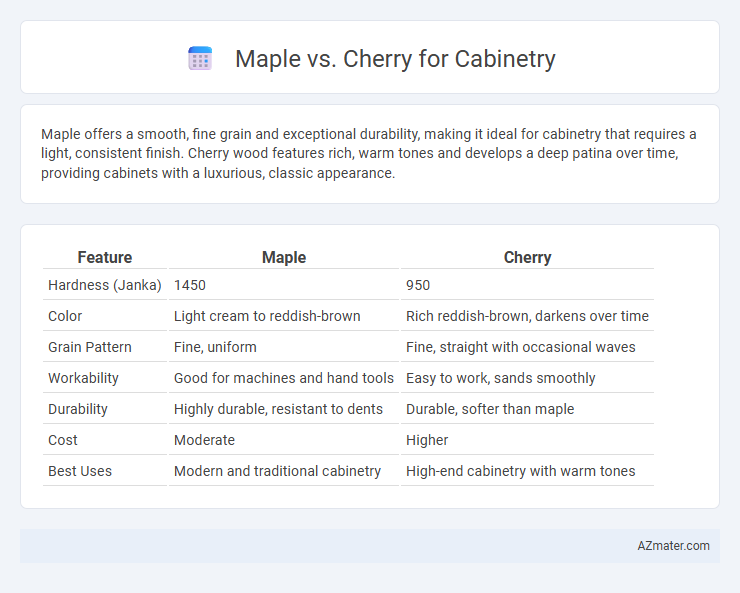Maple offers a smooth, fine grain and exceptional durability, making it ideal for cabinetry that requires a light, consistent finish. Cherry wood features rich, warm tones and develops a deep patina over time, providing cabinets with a luxurious, classic appearance.
Table of Comparison
| Feature | Maple | Cherry |
|---|---|---|
| Hardness (Janka) | 1450 | 950 |
| Color | Light cream to reddish-brown | Rich reddish-brown, darkens over time |
| Grain Pattern | Fine, uniform | Fine, straight with occasional waves |
| Workability | Good for machines and hand tools | Easy to work, sands smoothly |
| Durability | Highly durable, resistant to dents | Durable, softer than maple |
| Cost | Moderate | Higher |
| Best Uses | Modern and traditional cabinetry | High-end cabinetry with warm tones |
Overview: Maple vs Cherry Wood for Cabinetry
Maple wood offers a light, uniform grain with excellent hardness and resistance to denting, making it ideal for durable cabinetry in high-traffic kitchens. Cherry wood features rich, warm tones that deepen over time with exposure to light, providing a luxurious appearance but slightly softer durability than maple. Both woods are popular for cabinetry, with maple favored for strength and a clean look, while cherry is chosen for elegance and color variation.
Key Characteristics of Maple Cabinets
Maple cabinets feature a smooth, fine grain and a light, creamy color that provides a clean, modern appearance ideal for contemporary kitchen designs. Known for its exceptional hardness and durability, maple resists dents and scratches, making it a practical choice for high-traffic areas. The wood's ability to accept stains evenly allows for versatile finishing options, enhancing both natural and colored cabinetry styles.
Distinctive Features of Cherry Cabinets
Cherry cabinets showcase a rich, warm reddish-brown hue that deepens with age, creating a luxurious and timeless aesthetic. Their fine, straight grain with occasional smooth waves offers a refined texture that contrasts with maple's more uniform appearance. Known for exceptional durability and natural resistance to wear, cherry wood also develops a unique patina, enhancing its character and appeal in cabinetry.
Color and Grain Comparison
Maple cabinetry features a smooth, fine grain with a consistent texture, often showcasing a light creamy to pale reddish-brown color that complements modern and traditional designs. Cherry wood offers a richer, warm reddish-brown hue that deepens to a luxurious patina over time, paired with a straight grain that occasionally displays waves or curls for added character. Both woods provide distinct aesthetic qualities, with maple delivering a subtle, uniform appearance and cherry presenting a more vibrant, evolving color and grain pattern.
Durability and Hardness: Maple vs Cherry
Maple is known for its exceptional hardness, ranking around 1450 on the Janka scale, making it highly resistant to dents and wear in cabinetry. Cherry, with a Janka hardness of approximately 950, offers moderate durability and a softer surface that can develop a rich patina over time. For cabinetry where durability and resistance to impact are crucial, maple provides a more robust option, while cherry offers aesthetic warmth with adequate longevity.
Cost Analysis: Maple Cabinets vs Cherry Cabinets
Maple cabinets typically cost between $150 and $300 per linear foot, offering a more budget-friendly option compared to cherry, which ranges from $180 to $400 per linear foot due to its premium hardwood qualities. The cost difference stems from cherry's slower growth rate and richer, deeper hues that require more intensive processing. Homeowners seeking durable cabinetry with a refined aesthetic may find maple an economical choice without compromising on quality, while cherry cabinets serve well for higher-end designs with a willingness to invest more upfront.
Finishing and Staining Options
Maple cabinets offer a smooth, fine grain that allows for even staining and a sleek finish, making them ideal for modern or contemporary looks with consistent color tones. Cherry wood features a rich, natural reddish-brown hue that deepens over time, providing warmth and character with finishes that enhance its unique grain patterns. Both woods accept stains well, but maple's uniform texture results in a more predictable finish, whereas cherry's varied grain can produce a more dynamic, rustic appearance.
Design Flexibility and Style Compatibility
Maple offers exceptional design flexibility due to its smooth, consistent grain and light color, making it ideal for painted finishes, intricate carvings, and modern or traditional cabinetry styles. Cherry features a rich, warm tone with naturally beautiful grain patterns that develop a deeper patina over time, complementing classic, rustic, and elegant design aesthetics. Both woods provide style compatibility, with maple suited for versatile, contemporary looks and cherry enhancing sophisticated, timeless interiors.
Maintenance and Longevity
Maple cabinetry offers superior durability and resists dents and scratches better than cherry, making it easier to maintain with minimal refinishing over time. Cherry wood, known for its rich color that deepens with age, requires more frequent upkeep and refinishing to protect its softer surface from wear. Both hardwoods provide long-lasting cabinet solutions, but maple's lower maintenance needs make it a preferred choice for high-traffic kitchens.
Maple or Cherry Cabinets: Which Is Best for Your Home?
Maple cabinets offer a smooth grain and light, uniform color that enhances modern and contemporary kitchen designs, prized for their durability and resistance to dents and scratches. Cherry cabinets provide a rich, warm hue that deepens over time, adding a timeless, elegant look perfect for traditional or classic interiors. Choosing between Maple or Cherry depends on your desired aesthetic: Maple suits bright, clean styles, while Cherry brings warmth and character to your home.

Infographic: Maple vs Cherry for Cabinetry
 azmater.com
azmater.com